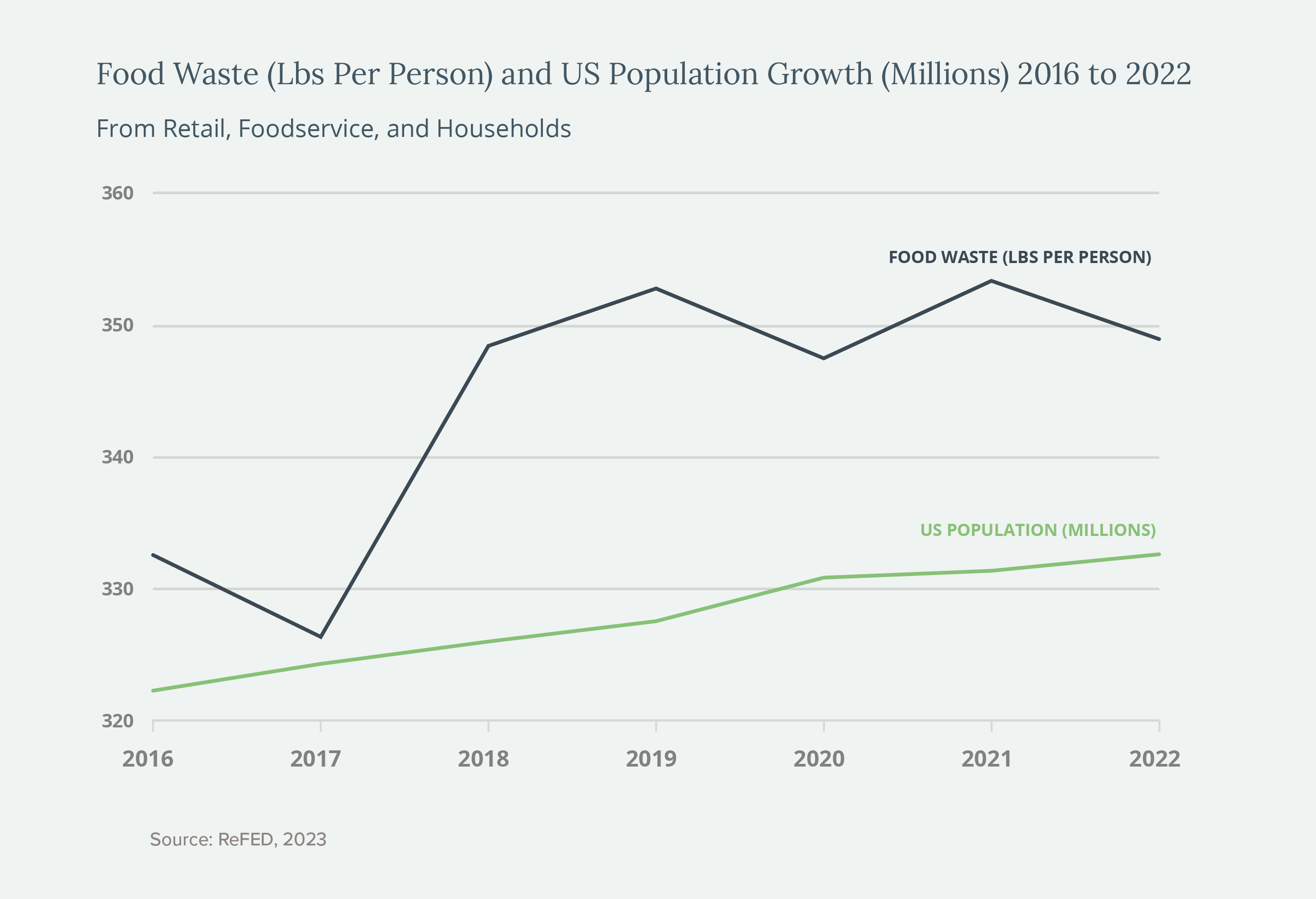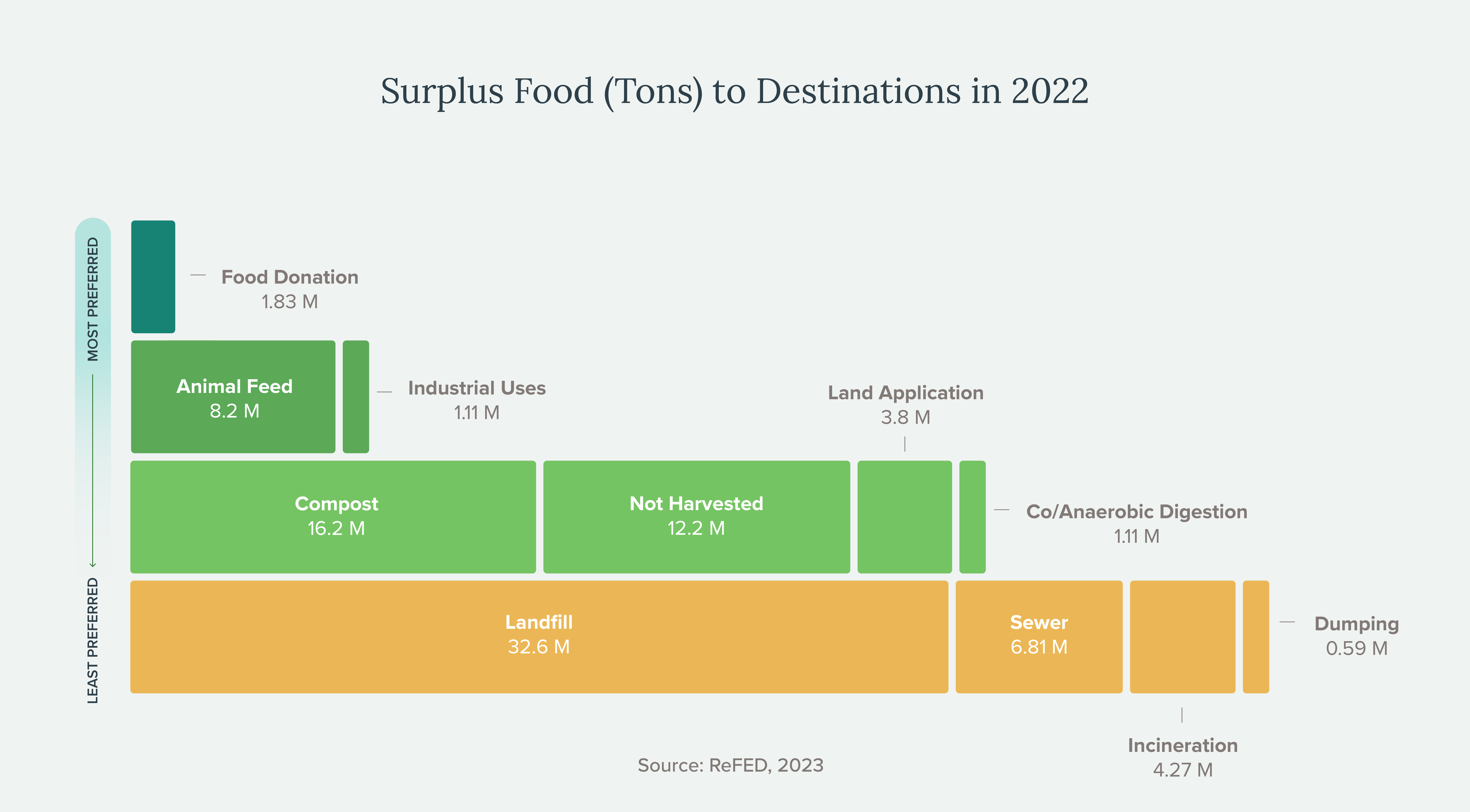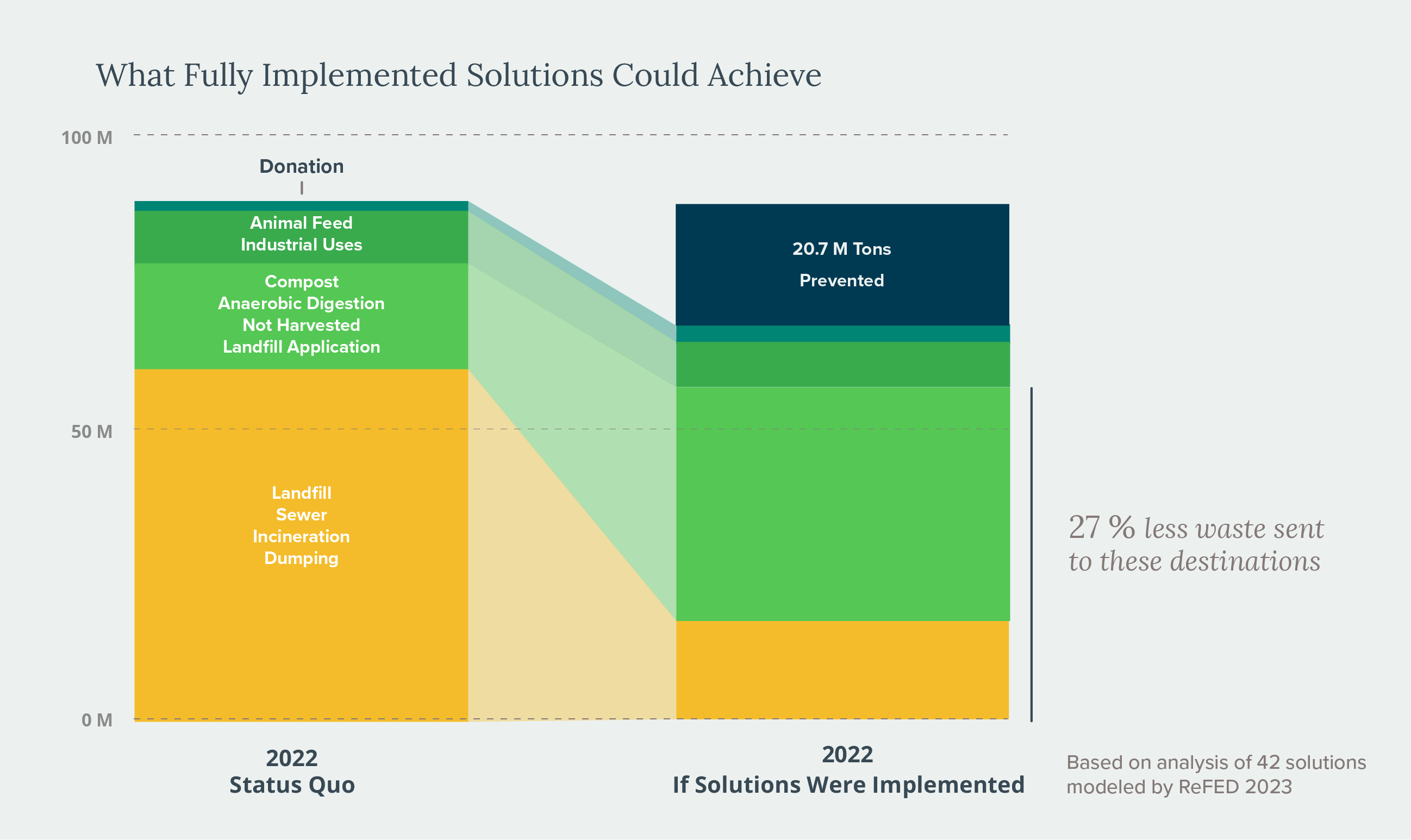The United States continues to struggle to reduce food surplus and waste1 across the food system, according to ReFED’s updated estimates for 2022. Last year, 88.7 million tons of food went unsold or uneaten in the United States – roughly 38% of the country’s total food supply. The vast majority of this – nearly 78 million tons of food – became food waste, meaning it failed to make it back into the human food supply chain. And in addition to releasing avoidable carbon dioxide and methane emissions, surplus and wasted food cost food businesses and consumers approximately $473 billion in 2022.
Progress Toward Reducing Surplus Food
ReFED estimates that total surplus food from farm to fork declined a modest 1.5% since 2021, with a corresponding 0.5% drop in associated emissions. Per capita food waste from consumer-facing sectors alone – foodservice (including restaurants), grocery retail, and residential – reached 349 pounds per person in 2022. This represents a 5% increase from the 2016 baseline2, but a 1.3% decrease from its peak in 2021. To achieve the EPA food waste reduction goal of 164 pounds per person by 2030, consumer-facing per capita food waste must decrease by 53% from its current high. While food waste from retail has continued to decrease since 2019, waste from foodservice actually increased from 2021 to 2022, likely due to the sector’s post-pandemic recovery. Similarly, food waste from households has continued its decline from its peak in 2020.

Environmental Impacts of Surplus and Wasted Food
Food waste has profound environmental consequences. In 2022, surplus food contributed 6.1% of U.S. greenhouse gas emissions, equivalent to driving 86 million passenger vehicles – more than the registered cars in California, Texas, Florida, and New York combined – for a year. Producing surplus food also required 22.1 trillion gallons of water, representing 22% of the country’s freshwater use; the land required to produce surplus food accounted for 16% of cropland use.
Most greenhouse gas emissions from food waste are generated before it makes it to the dinner table. ReFED’s analysis indicates that 93% of emissions from surplus food stem from “upstream” activities, such as production, processing, transportation, storage, and preparation. That means preventing food from becoming waste is the most effective strategy for cutting food waste emissions. Where prevention is not possible, however, the steps taken to manage surplus food material will influence emissions tradeoffs. The EPA’s new Wasted Food Scale reflects these strategic environmental priorities. The most preferred “pathways” are those where food is used for its intended purpose: to nourish people. The least preferred pathways – landfilling, incineration, and sewer – have the largest environmental impacts and limited circularity potential.
Methane is a potent greenhouse gas, but only persists in the atmosphere for a relatively short time - meaning that methane emissions we keep out of the atmosphere today will have a cooling effect within the next 10-15 years. Because of this, addressing methane is increasingly recognized as a key strategy for keeping warming under 1.5°C by 2050. A new EPA report finds that nearly 60% of all landfill methane emissions are from food. In addition, because food tends to decay more rapidly than other materials in landfills, the methane produced is likely to be released before landfill gas capture and cover systems can be installed. Therefore, it’s critical that food be kept out of landfills entirely, even if they’re implementing control technology – first by preventing as much food from being disposed of, then by rescuing food back into the supply chain, and finally by diverting the unavoidable remainder from landfills to compost, anaerobic digestion, and other more preferred destinations.
The chart below shows ReFED’s estimates for the amount of surplus food currently going to each destination, arranged from most preferred destinations to least preferred. Nearly 50% of surplus food is currently sent to landfill, sewer, incineration, or dumped. Another 38% is composted, left in fields to decompose, applied to land as soil amendment, or anaerobically digested – a preferable outcome to landfill. But this still means that unnecessary food production is generating avoidable emissions. Only 11% of surplus food is ultimately channeled back into the human food supply chain, where it is consumed, donated, or incorporated into animal feed.

Impact of Solutions to Surplus Food
The good news is that businesses and consumers can adopt concrete behaviors, processes, and technologies to use existing food resources to feed people and repurpose the remaining waste to feed animals, generate energy, and enhance soil health. ReFED estimates that completely adopting the 42 modeled solutions in ReFED’s Solutions Database would avoid more than 113 million metric tons CO2e of greenhouse gas emissions, save 6.2 trillion gallons of water, and recover through donation the equivalent of 4.16 billion meals each year. In addition to these impacts, implementing these solutions would yield substantial financial gains, with an impressive 5:1 return on investment.
Implementing these solutions – which span prevention, rescue, and recycling strategies – would keep an additional 20.7 million tons in the human supply chain. This constitutes a 27% reduction in food waste and amounts to 127 fewer pounds of food waste per person. (Significant additional reduction potential resides in best practices, process improvements, new technologies, and policy changes not currently reflected in ReFED’s Solutions Database.)
The chart below illustrates how surplus food would be distributed across pathways in the status quo scenario (on the left), and what the distribution would look like if all 42 solutions in ReFED’s Solutions Database were implemented (on the right).

Narrowing the Financial Divide To Scale Food Waste Solutions
Food waste remains a persistent problem, and increased philanthropic and private funding is crucial to scaling up effective solutions. ReFED estimates that $1.4 billion in philanthropic funding – six times the historical average (including indirect food waste funding to food banks) – is needed annually to scale food waste solutions. Notably, even as the recognition of the role of reducing food waste to cut GHG emissions grows, direct philanthropic contributions from individuals and foundations in this space only make up 3% of climate funding in North America.
While private sector backing in funding food waste solutions is outpacing philanthropic support, historical investment data indicates that private funding also falls short of the current need. In fact, it has declined by nearly 40% from 2021 through November 2023. Over the same period, private investment has shifted away from prevention solutions in favor of recycling solutions – a concerning pattern given that $2.7B (80% of the total $3.4B for all solutions) is needed annually for prevention solutions from venture capital, private equity, and impact investing – triple the historical average.
Although the current capital-constrained environment is insufficient to meet food waste funding needs, recent signals by the government and the private sector may contribute to a more favorable investment climate. In December, the Biden-Harris Administration released its Draft National Strategy for Reducing Food Loss and Waste and Recycling Organics, elevating food waste reduction to a national priority. Furthermore, pre-competitive collaborations between public and private entities, including the newly launched U.S. Food Waste Pact – which includes Walmart, Whole Foods, Sodexo, and more as signatories – show that businesses understand the importance of working together to drive progress on food waste reduction goals.
Getting Back on Track for 2030
While the U.S. has not made the overall progress we would hope to see to reduce food waste, there are clear paths forward to maximize impact – whether through emissions reduction or food recovery. A recent MITRE-Gallup Survey revealed that 86% of American households recognize the need to intensify efforts to reduce food waste. The release of a new federal food waste reduction strategy, the prominence of food waste reduction as a climate strategy at COP28, the momentum building behind initiatives like the U.S. Food Waste Pact, and the growing list of corporate and national food waste reduction success stories all indicate that meaningful change is possible. It’s time for businesses, the government, and consumers to translate shared concerns into collective action to solve food waste in pursuit of a more sustainable future.
1Surplus Food = All food that goes unsold or unused by a business or that goes uneaten at home – including food and inedible parts (e.g., peels, pits, bones) that are donated, fed to animals, repurposed to produce other products, composted, anaerobically digested, or wasted.
2Note that ReFED calculates the 2016 baseline to be 333 lbs/person. EPA, using a different methodology, estimates the 2016 baseline to be 328 lbs/person
